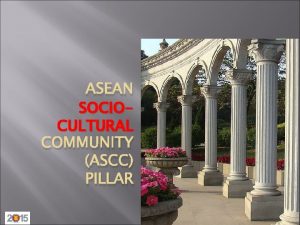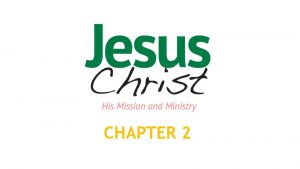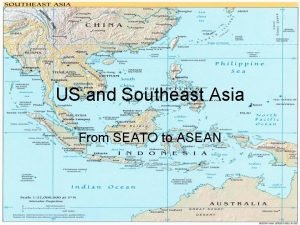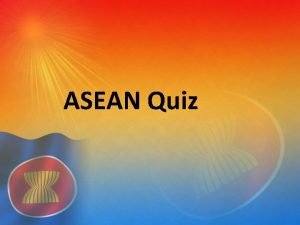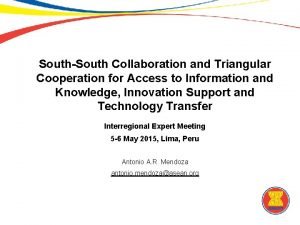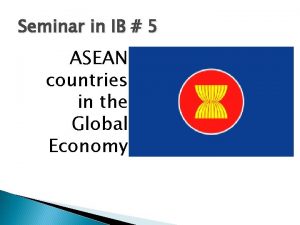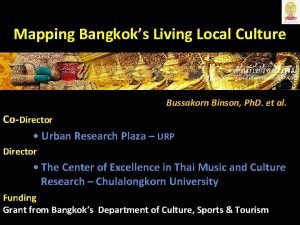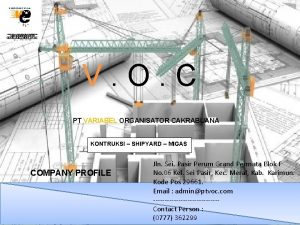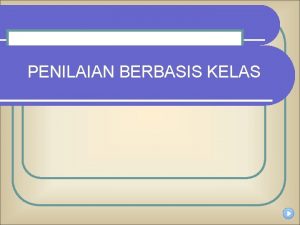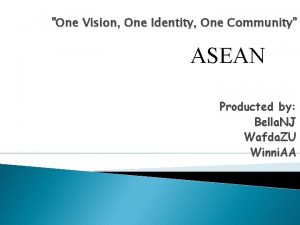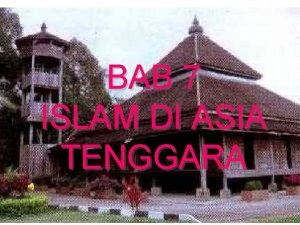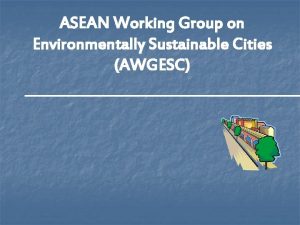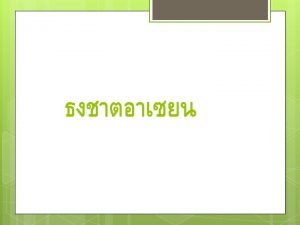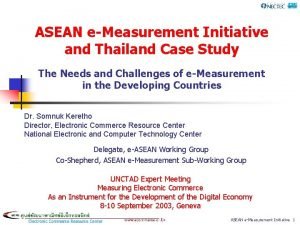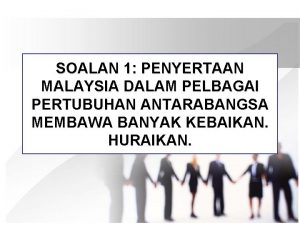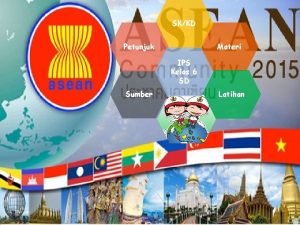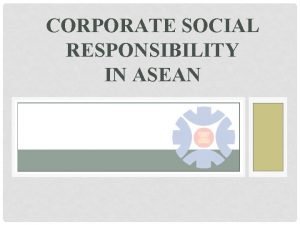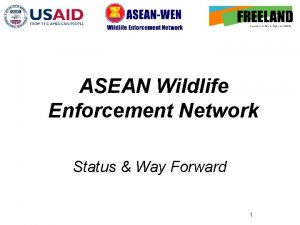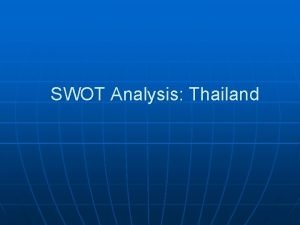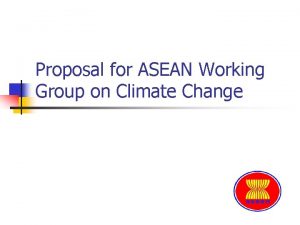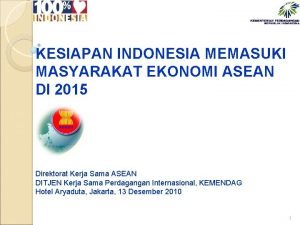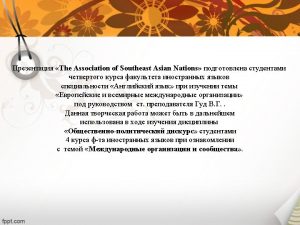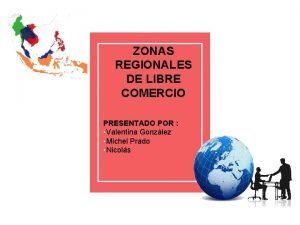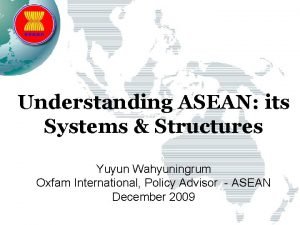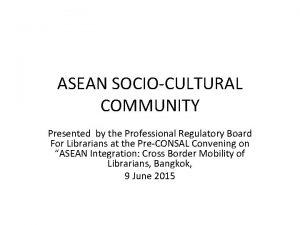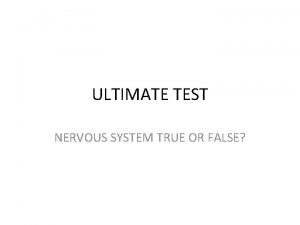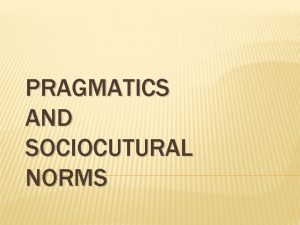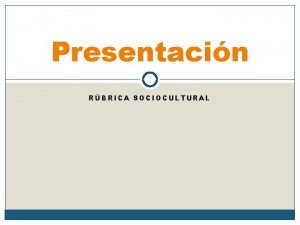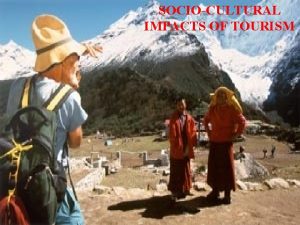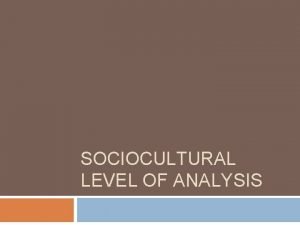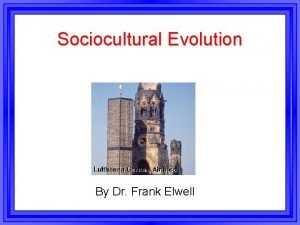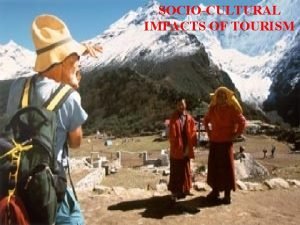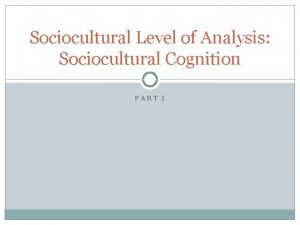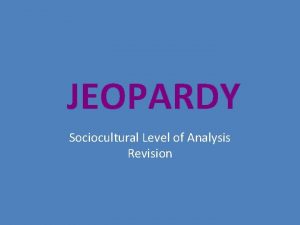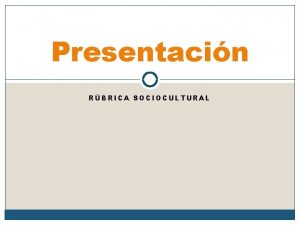ASEAN SocioCultural Community ASCC The true and ultimate


























- Slides: 26

ASEAN Socio-Cultural Community (ASCC) ����������� �����


“The true and ultimate measure of the ASEAN Community’s success is how well and to what extent the Community has brought meaningful and positive change to its 600 million constituents” Former Malaysian Prime Minister Tun Abdullah Ahmad Badawi, Opening Address at the 10 th ASEAN Leadership Forum, 18 July 2013, Kuala Lumpur, Malaysia

• For this reason, Malaysia has identified the creation of a truly `People. Centred ASEAN’ as the central element and overarching theme of our Chairmanship of ASEAN in 2015. A `People-Centred ASEAN’ will be a sharper instrument for the realisation of our peoples’ dreams – more effective and responsive governance, better standards of living, strengthened environmental protection, further empowerment of women and greater opportunity for all. A `People-Centred ASEAN’ will see the more direct involvement of all sectors of society in ASEAN’s activities. No longer will ASEAN be the domain of the elites and specialists alone. An ASEAN Community which is people-centred will truly be `One ASEAN For All’. • I am also heartened that some ASEAN members have responded by proposing specific measures to deliver this vision. For example, Thailand has spoken of making universal healthcare as one of the targets in the successor document. Dato' Sri Mohd Najib bin Tun Haji Abdul Razak, Prime Minister of Malaysia at THE OPENING SESSION OF THE NATIONAL COLLOQUIUM ON MALAYSIA’S CHAIRMANSHIP OF ASEAN 2015, Kuala Lumpur, 8 April 2014


������� �ASCC “The primary goal of the ASCC is to contribute to realizing an ASEAN community that is people-centred and socially responsible with a view to achieving enduring solidarity and unity among the nations and peoples of ASEAN by forging a common identity and building a caring and sharing society which is inclusive and harmonious where the wellbeing, livelihood, and welfare of the peoples are enhanced. ” (ASCC Blueprint 2009 -2015) ������������������� ������������������������������������������������������������


ASCC SECTORAL BODIES Ministerial Plus Senior Officials Level Bodies • • • • 1. ASEAN Ministers Responsible for Information (AMRI) 2. ASEAN Ministers Responsible for Culture and Arts (AMCA) 3. ASEAN Education Ministers Meeting (ASED) 4. ASEAN Ministerial Meeting on Disaster Management (AMMDM) 5. Conference of the Parties to the ASEAN Agreement on Disaster Management & Emergency Response (COP) 6. ASEAN Ministerial Meeting on the Environment (AMME) 7. Conference of the Parties to the ASEAN Agreement on Transboundary Haze Pollution (COP) 8. ASEAN Health Ministers Meeting (AHMM) 9. ASEAN Labour Ministers Meeting (ALMM) 10. ASEAN Ministers on Rural Development and Poverty Eradication (AMRDPE) 11. ASEAN Ministerial Meeting on Social Welfare and Development (AMMSWD) 12 ASEAN Ministerial Meeting on Youth (AMMY) 13. ASEAN Conference on Civil Service Matters (ACCSM) 14. ASEAN Ministerial Meeting on Women (AMMW) 15. ASEAN Ministerial Meeting on Sports (AMMS) 16. ASEAN Ministerial Meeting on Science & Technology (AMMST)

ASCC SECTORAL BODIES (Senior Officials- Level ) • 17. ASEAN Committee on the Implementation of the ASEAN Declaration on the Promotion & Protection of the Rights of Migrant Workers (ACMW) • 18. ASEAN Commission on the Promotion & Protection of the Rights of Women & Children (ACWC) • 19. ASEAN Centre for Biodiversity (ACB) • 20. ASEAN Coordinating Centre for Humanitarian Assistance on Disaster Management (AHA Centre) • 21. ASEAN Earthquake Information Centre • 22. ASEAN Specialised Meteorological Centre (ASMC) • 23. ASEAN University Network (AUN)

GENERAL SUMMARY OF STATUS OF IMPLEMENTATION (Source: ASEAN Secretariat presentation, Nov. 2013) Status of Implementation ����� 1. ������� Total no. of actions Pending/ No. Implementation/ No Completed Ongoing Information Available 61 1 54 6 77 14 15 8 4. ������������� 98 7 ����� 64 27 5. ������������ 50 0 47 3 6. ������������ 8 1 7 0 264 58 2. ������������� 94 3 ��� 3. ���������� 28 ��� 339 5 17



����� – ����� • Prioritization within the ASCC Blueprint ������������������ • Enhancement of the ASCC monitoring tools ������������������ • Knowledge management system �������� • Coordination and cross-sectoral mechanisms ������������������ • Resource mobilization �������� • Multi-sectoral and multi-stakeholder participation ������������������ • Communication strategy ���������� • Special consideration for CLMV countries ����������������� ������


������� ����� The IAI Work Plan II composing of 182 actions aims to assist the CLMV countries to achieve their commitments under the framework of the ASEAN Community by 2015. (data as of Sep. 2013) Sectors Number of Total Actions Number of Actions Addressed Number of Total Projects Completed Projects Under Implementation/ Ongoing / In-Process/ In the Pipeline AEC 94 32 97 82 15 ASCC 78 18 83 74 9 APSC 6 4 8 6 2 GEA 4 4 57 54 3 Total 182 58 245 216 29


ความทาทาย Declining budgetary outlays IAI Phase I (2002 -2008) Over USD 200 million IAI Phase II (2009 -2015) ≈ USD 20 million� ADB, Australia, China, Germany, India, Japan, Republic of Korea, Switzerland USA for example, have started their own cooperative schemes with countries in the Mekong sub-region in recent years. This shows that there is increasing competition of interest and for funding of program activities in the CLMV/Mekong sub-region. � Based on data obtained from ASEAN Secretariat’s IAI/NDG Division, as of Sep. 2013

EDII MPAC EU US - LMI IAI/ AMBDC Mekong - Japan Mekong -ROK AADCP II GIZ, etc. ADB Pan-Beibu / GMS Boao Forum 5/20/2021 Lancang Mekong AFEED Swiss Mekong TICA, NEDA MRC ACMECS DEV’T Triangle Australia Mekong MTCP ISSTC SCP 18

����������� 2015 • ����� “The World We Want” ��������� 5 ���������� 2013 Report of UN SG’s High Level Panel of Eminent Persons on the Post-2015 Development Agenda 1. Leave No One Behind: ����������������� 2. Put Sustainable Development at the Core: ������������ 3. Transform Economies for Jobs & Inclusive Growth: �������������������������� 4. Build Peace & Effective, Open & Accountable Public Institutions: ������������������������� 5. Forge a New Global Partnership: ��������������� • ������ (ASEAN) “The ASEAN We Want” • ������ “The ASEAN Thailand Wants”

����������� 2015 – �������� • Politically Cohesive • Economically Integrated • Socially Responsible • People-Oriented • People-Centered • Rules- Based �������������������� 2558 ������ 9 ������ 2556

��������� 2015 • The ASEAN Socio-Cultural Community’s primary goal and mission is to advance an ASEAN Community that puts people at its center and accords the highest value to learning, sharing, service, justice and the protection of rights; celebrates the region’s cultural wealth; extols prudent stewardship of natural resources; and is dedicated to enabling people to have access to opportunities to live and thrive in resilient, innovative and dynamic communities. Provisional Vision Statement, Second ASCC Working Group Meeting, Jakarta, 17 July 2014

����������� 2015 – ������� From Millennium Development Goals (MDGs) to Sustainable Development Goals (SDGs) to ASEAN Development Goals (ADGs)? ���������������������� Reframe/Update ASEAN Roadmap Towards Realizing the MDGs for addressing post-2015 priorities and challenges ���������������������� MDGs ��������������� 2015 Reframe/Update the Initiative for ASEAN Integration (IAI) Work Plan for post 2015 realities and issues ���������� IAI ��������������� 2015 Adjust ASEAN Framework on Equitable Economic Development (AFEED) to post-2015 circumstances ���������������������� IAI ���������� 2015 Realigning other relevant ASEAN frameworks/initiatives Incorporating relevant elements from the Bali Concord III Action Plan, 2013 -2017 �������������������������������������������� 3 �� 2556 -2560



������� 5. Good neighborliness and mutual understanding - of different languages, cultures, social-ethnic fabric, faiths & beliefs, multiple identities, etc. �������������������� – ��������������������� ���� 6. Learning from each other and across disciplinary/sectoral lines as opposed to silo mentality or business as usual. Good coordination needed ������������������������� 7. Comprehensive benefit/cost analysis of the positive and negative aspects of economic integration and community building – who gains and who loses, where, when and how and to what degree/Legal vs illegal means �������������������� 8. Addressing inequalities and closing the gaps/divides � �������������������� 9. Analysis of inter-linkages and nexus among all the ASEAN Community pillars in terms of policy and operational implications �������������������� 10. National/Individual vs Regional/Collective Identity & Interests – search for win-win solutions �������������������� /�������� /��� �� ���������������������

 Asean socio-cultural community pillar
Asean socio-cultural community pillar Asean one vision one identity one community
Asean one vision one identity one community Chapter 2 jesus christ true god and true man
Chapter 2 jesus christ true god and true man Seato
Seato Asean quiz bee question and answer
Asean quiz bee question and answer True or false true or false
True or false true or false The three pillars of asean
The three pillars of asean The three pillars of asean
The three pillars of asean Asean culture
Asean culture Pengertian organisator
Pengertian organisator Contoh penilaian berbasis kelas
Contoh penilaian berbasis kelas Asean one vision
Asean one vision Peta konsep kerajaan perlak
Peta konsep kerajaan perlak Awgesc asean
Awgesc asean Flag with red on top and white on bottom
Flag with red on top and white on bottom E-asean
E-asean Penyertaan malaysia dalam pertubuhan dunia
Penyertaan malaysia dalam pertubuhan dunia Negara laos beribukota di
Negara laos beribukota di Asean countries
Asean countries Awen
Awen Asean wildlife enforcement network
Asean wildlife enforcement network Asean swot analysis
Asean swot analysis Asean working group on climate change
Asean working group on climate change Asean secretariat
Asean secretariat Asean countries
Asean countries Asean ventajas y desventajas
Asean ventajas y desventajas Yuyun wahyuningrum
Yuyun wahyuningrum
